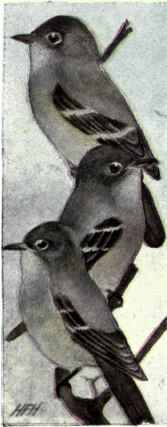469. Wright's Flycatcher. Empidonax Nrighti
Description
This section is from the book "The Bird Book", by Chester A. Reed. Also available from Amazon: The Bird Book.
469. Wright's Flycatcher. Empidonax Nrighti
Range. - Western United States, breeding from the Mexican border to Oregon and wintering south of the United States.
A very similar bird to the last but whiter below. It is a much more abundant species than the last and is found breeding in open woods and thickets on all the ranges. The nests are built like those of the Least Flycatcher and nearly always are found in the crotch of trees or bushes at a low ele-ation; their nests, like those of the two preceding species, bear a strong resemblance to those of the Yellow Warblers which are found in the same localities and locations. The eggs are pale creamy white, four in number and measure .68 x .52,

White.

482 - 469 - 469.1

White.

White.

469.1. Gray Flycatcher. Empidonax Griseus
Range. - Lower California, north to southern California.
This is a slightly larger species than the preceding and is grayish above and paler below, with little or no tinge of brownish or yellow. As far as I can learn its eggs have not yet been taken.
470a. Buff-Breasted Flycatcher. Empi-Donax Fulvifrons Pygmaeus
Range. - Western Mexico, north to southern New Mexico and Arizona.
This small bird, which is but 4.75 inches in length, is brownish gray above and brownish buff below. It is not a common species anywhere, but is known to nest during June or July, on high mountain ranges, saddling its nest of fibres, covered with lichens, on horizontal boughs at quite an elevation from the ground. The eggs are pale buffy white, unspotted, and measure .60 x .50.
Continue to:


